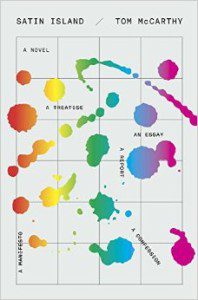
On the cover of Tom McCarthy’s new novel, a number of words appear crossed out. “A manifesto,” “an essay,” “a report,” “a confession,” and “a treatise” are all struck through, leaving only the words “a novel” un-slashed. But none of these terms quite captures what Satin Island really is: a polemic. Here Tom McCarthy fully embraces his notion of “invented reality” that he espoused last December in the London Review of Books. He quotes J.G. Ballard’s introduction from his 1973 novel Crash: “We live inside an enormous novel,” Ballard writes, “It is now less and less necessary for the writer to invent the fictional content of his novel. The fiction is already there. The writer’s task is to invent the reality.” McCarthy reminds us that “Realism is a literary convention – no more, no less – and is therefore as laden with artifice as any other literary convention,” as if artifice were the death knell of any realist work. He lauds Burroughs’ cut-up technique and asserts, “20th-century avant-garde often paints a far more realistic picture of experience than 19th-century realists ever did.”
Despite the hue of postmodernity in McCarthy’s argument, this idea is not new. Near the end of the 19th century Oscar Wilde, in his essay “The Decay of Lying,” makes the following comparison: “The difference between such a book as M. Zola’s L’Assommoir and Balzac’s Illusions Perdues is the difference between unimaginative realism and imaginative reality.” Though unwilling to fully praise Balzac’s novels (“He set far too high a value on modernity of form,” Wilde ruefully notes), Wilde does extol Balzac’s creative power: “He created life, he did not copy it.”
So here, now, is McCarthy’s coup de grâce on realism, his fourth novel, Satin Island. Here we get almost no descriptions of characters, places, or things. Here we have characters with only first names––Madison, Daniel, etc.––and a protagonist referred to only as U. Here we have an eerily cryptic corporation involved in an even murkier project called Koob-Sassen. Like Burroughs’ cut-up technique, Satin Island traces four disparate narratives in which the only correlative tissue is U., our mysterious corporate anthropologist, assigned the task of composing The Great Report, a be-all-end-all statement on our epoch. The stories, if we can call them that, have little or no thrust, no narrative momentum. Instead, they greatly suggest meaning with proximity yet seem to mock you for finding any. In other words, McCarthy throws out many of the so-called rules of fiction writing in order to depict something he believes to be greatly missing from realism: the erratic and associative movements of the mind.
In his essay, McCarthy quotes Ford Madox Ford, who, according to McCarthy, “brilliantly skewers the claim that a certain prose style––that of realism––faithfully and objectively captures historical events and mental activity.” Here is, in part, the quotation:
Life does not say to you: in 1914 my next-door neighbour, Mr Slack, erected a greenhouse and painted it with Cox’s green aluminium paint … If you think about the matter you will remember, in various unordered pictures, how one day Mr Slack appeared in his garden and contemplated the wall of his house. You will then try to remember the year of that occurrence and you will fix it as August 1914 because having had the foresight to bear the municipal stock of the City of Liège you were able to afford a first-class season ticket for the first time in your life. You will remember Mr Slack – then much thinner because it was before he found out where to buy that cheap Burgundy of which he has since drunk an inordinate quantity though whisky you think would be much better for him!
Ford wrote those words in 1924, at a time when many other Modernist novelists were trying to depict this very thing. Virginia Woolf, James Joyce, William Faulkner, and Gertrude Stein all embraced an essentially, in McCarthy’s definition, anti-realist view. The point is that writers and critics have long argued the merits of realism, and have implemented their stances in their art. But what makes Satin Island different from, say, To the Lighthouse or Ulysses is that it not only embodies this tradition but also argues for it. McCarthy’s novel is a polemic against the aspirations of realist novels and novelists, which are dismissed as ultimately fruitless (though intoxicating) enterprises.

Here’s what I mean. When U. is assigned the “Great Report” from his vague but very cool boss Peyman, he’s told to write “the Document… the Book. The First and Last Word on our age.” When U. expresses concern by noting that anthropology has greatly changed in the last century, Peyman tells him not to worry, that the Report will “find its shape.” Throughout, U. continually considers his impossibly grand task. He cites Lévi-Strauss, his hero, and notes: “I spent my twenties wanting to be Lévi-Strauss––which is ironic, since he spent most of his life wanting to be somebody or something else: a philosopher, say, or novelist, or poet.” He evokes Bronislaw Malinowski’s dictum “Write Everything Down” but soon ceases the practice. “What if,” he wonders, “rather than it finding its shape, the age itself, in all its shape-shifting and multi-channeled incarnations, were to find and mold it?” His most exciting development comes when he postulates what he calls “Present-Tense Anthropology… an anthropology that bathed in presence, and in nowness.”
This is McCarthy’s model for contemporary realism, a kind of homogenized and corporatized attempt to characterize an era, to capture the nowness of things in a text. McCarthy, so dismissive of what he condescendingly refers to as “Oprah literature” (which he characterizes as “candid confession and exposure of personal peccadillos”) takes aim at these endeavors with a strange airiness, a lightness, as if he assumes the reader agrees with his thesis. U. is never going to write the “Great Report,” just as Satin Island fails to deliver a meaty or meaningful climax, both of which become clear very early on in the novel. By the end––during which time McCarthy eschews realism’s commitment to characterization, rising action, plot, and heart––Satin Island can be seen for what it is: an intellectual enterprise formulated on McCarthy’s ideas on realism more than reality.
McCarthy knows how to tell a story, as evidenced in his previous novels, especially Remainder, which creates its own reality, focusing its narrative attention on the protagonist’s altered mind, all while riveting the reader with causality, momentum and meaning. With Satin Island, McCarthy makes an argument for the future of fiction, for the futility of contemporary fiction. But he forgets a few vital aspects of storytelling. First, his essay on realism carries with it an implicit contention about fiction itself: that it has a responsibility to depict reality. This, of course, is not at all true. Fiction has no responsibilities to anyone or anything. Sure, to aspire to reflect the real world or create one’s own are worthwhile pursuits, but they are no more required of a novel than last names or descriptions. McCarthy has every right to produce a book like Satin Island, but he would be remiss if he thought it amounts to anything more than his own version of a narrative aesthetic. And it seems his version isn’t very interested in depicting reality, because his characters and the world he invents are missing one crucial component: humanity.




